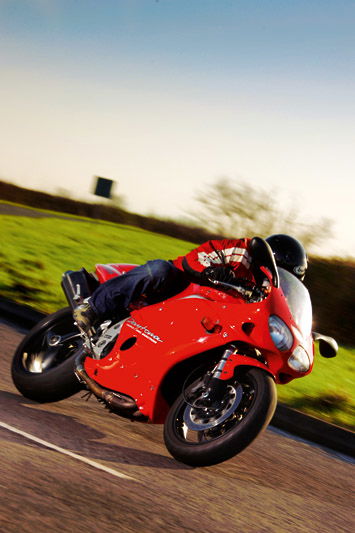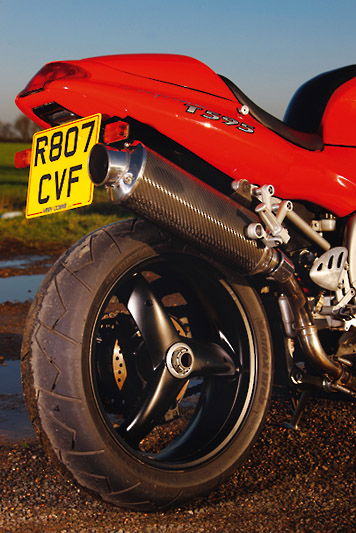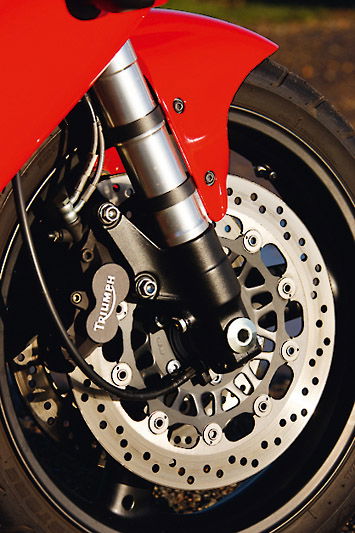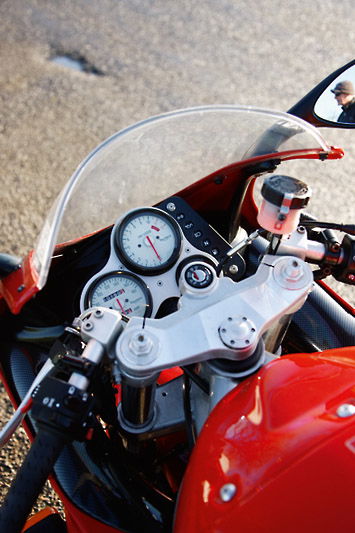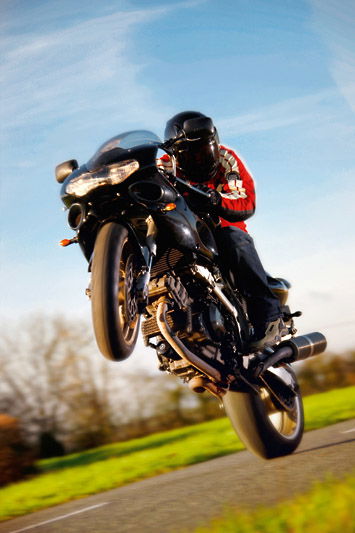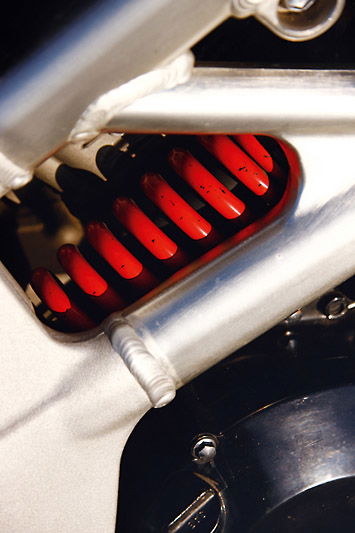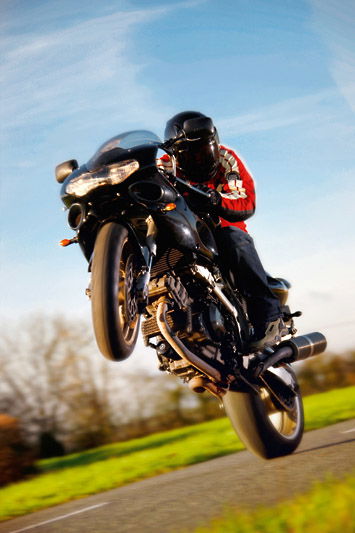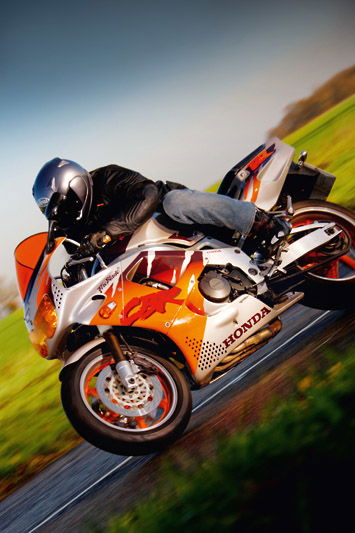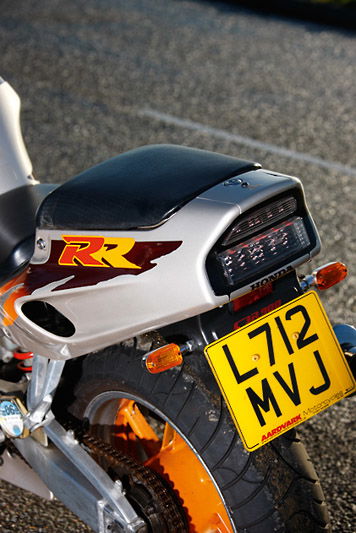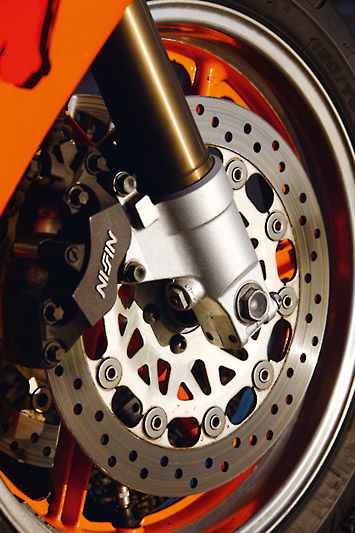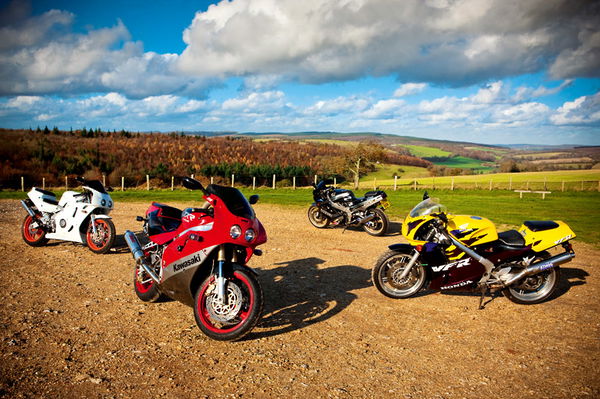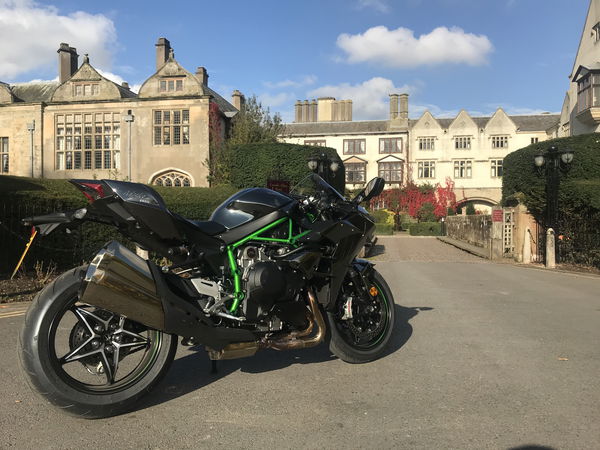Future Classics: 97 Suzuki TL1000S, 94 Honda Fireblade & 98 Triumph T595 Daytona
Looking for an excuse to buy a bike that’s both great fun and a potential money-maker? Each of these beauties costs less than £2,500 but all are future classics still just flying below the radar of mainstream popularity. Try these three for size. Go on
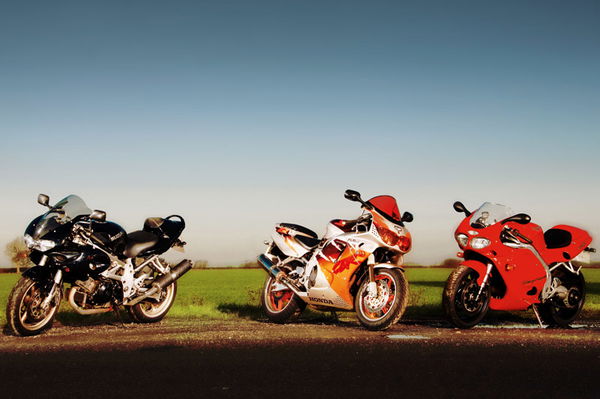
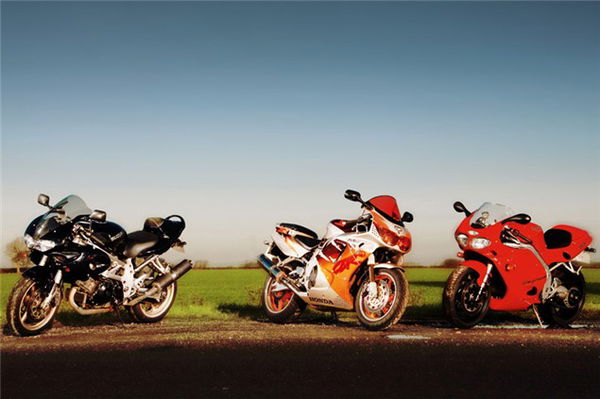
The futures market is a hard one to predict. Unless you’ve secretly invented a flux-capacitor, strapped it to the back of your VFR and disappeared in a trail of flames across a Sainsburys’ carpark while a crazy old man with mad hair screams excitedly, you will have no idea what the future holds. But it is possible to have a fairly good guess, especially when it comes to investing in a potential classic bike.
Bricks and mortar are a sound investment, unless you live on a flood plain or near a rapidly eroding cliff but what’s the fun in sticking your cash in a house? Why not invest in something that you can actually enjoy? Which is where these three bikes come in.
Fairly obviously we’re not going to pretend buying a 1998 Triumph and hanging onto it for five years will make you a millionaire, but what each of these three bikes will do is hold their value, and quite possibly even improve on it. When it comes to justifying the purchase this makes them an ‘investment’. So what have we got?
Having set ourselves a maximum spending limit of £2,500 we searched the secondhands to see what potential classics had yet to start reaching silly money. The first to catch our eye was a Triumph T595 Daytona, the first ‘proper’ sportsbike to come out of Hinckley and a firm favourite with Triumph fans. At £2,500 this bike was not only mint, it was also a certain classic. Next was Suzuki’s TL1000S. When you are looking at a future investment the bike needs a reason for becoming a classic, and what better than a reputation as one of the nastiest bikes ever launched? Perfect, and at £2,195 it was cheap, if a little tatty. Finally a 1994 FireBlade caught the eye. In truth the stunning Urban Tiger paint scheme did. The 1994 isn’t as popular as the original 1992/93 model, but it’s still an early Blade and a bike that many have fond memories of.
So, with our assembled collection, which has a total cost less than a modern 600, we headed out onto cold roads to see if they’d be money well invested, or the motorcycling equivalent of involvement in a sub-prime loan…
1998 Triumph T595 Daytona
The bike the ‘modern’ Triumph factory was built on. A definite future classic with a strong, willing engine and a look that remains fresh and oddly appealing even now. And it’s British to boot
Click to read: 1998 Triumph T595 Daytona owners reviews
The T595 was the first Triumph to have fuel injection (even Honda’s Blade and the 1998 R1 didn’t have this) but what inspired the buying public was the 955cc triple engine and graceful, swooping bodywork. But it also caused some confusion.The T595 was only called a T595 for two years, in 1999 it was renamed 955i because people thought it was a 600. Potential sales were lost over the pond because the Americans didn’t fancy being seen on tiny little ‘600s’.
Next to the Triumph the FireBlade looks chunky and the TL bulbous but the Daytona doesn’t seem like a 13 year-old design. In fact it’s hard to put a date on its look, which is one of Triumph’s selling points. Build a bike that doesn’t date and you avoid having to update it every time fashion changes.
Hit the starter and the triple snarls into life. Like many secondhand Triumphs this T595 has a factory aftermarket carbon race can and by god it sounds good as the triple engine rasps and pops with blips of throttle.
Sit on the bike and it has that 1990s feel of lowness. Unlike modern race reps the back end isn’t kicked up in the air and the Triumph’s seat has levels of padding you’d expect on a tourer. Glance in the cockpit and the three dials are just perfect. Pull in the extremely light clutch and with an almighty clunk first gear can be engaged. The T595’s gearbox is an instant reminder of Triumph’s bad old days. How a company with no history of tractor manufacture could create such an agricultural box is a mystery and the shift doesn’t really improve with engine revs. But you can forgive this slight irritation, riding the Daytona is a fantastic experience.
The three-cylinder engine not only sounds amazing, it pulls with a beautifully smooth, strong spread of torque that’s makes for incredible flexibility. It’s always said triples combine the best aspects of twins and inline fours and the Daytona demonstrates this perfectly. From low in the rev-range it drives cleanly and even has a bit of of a zing in its top-end for thrills. Call it hassle-free riding, there’s no need to search for power. But if you want to go silly you can rev it out for more. And the handling is up to the job.
The Daytona’s chassis feels balanced and eager. It doesn’t have sportsbike levels of responsiveness, but feels assured and solid. The suspension is set on the soft side, but for road use that’s perfect and I’d rather have a relaxed and responsive machine like the Triumph to enjoy at the weekend than a feisty plank like the Blade. You could easily imagine covering decent miles on a T595 and even use it as a commuter, although avoid paces where the gearbox is too frequently clunked into action. Like towns or cities. Oh dear.
Having initially had reservations about the T595 I can see why it’s such a popular secondhand bike. It looks good, rides well and sounds fantastic. A future classic? Reckon so but it’s also a fine secondhand buy in its own right.
Triumph T595 Daytona Essential Info
Prices
From £1,350 (1998, 28,000 miles) to £2,500 (1998, 18,000 miles)
The plucky Brit pretender to the Japanese sportsbike crown couldn’t quite make the grade. It was outclassed in terms of outright performance but considered an excellent real world alternative. There isn’t a huge selection when it comes to buying used, as the T595 appears to be a bike owners hold on to for a while rather than chop in for the latest model. Few bikes will be standard but there’s no need to fear modified bikes as many of the extras will be proper items from Triumph’s vast official accessories catalogue.
Instant upgrades
- Exhaust: that glorious sound from the inline triple shouldn’t be restricted by standard pipes, so replacing the standard end-can is a good idea. Trident is the Triumph specialist division of Wolf exhausts and they make a range of cans for the T595, available in round or oval and in a range of finishes, as well as the option of standard height or high level fitment. From £169 (www.trident-exhausts.co.uk).
- Tyres: the Daytona isn’t really regarded as an out and out sportsbike these days, more of a sporty sports tourer. Given this, the majority of owners fit modern sports touring rubber to the bike for the best of both worlds; plenty of grip through the bends in any weather but with excellent tyre life. Bridgestone’s BT-021 is a popular choice at around £205 a pair (www.bridgestone.co.uk).
- Screen: to make the best use of the T595 as a sports tourer a double bubble screen aids comfort by directing windblast over the rider’s head, rather than straight at it, making an uncomfortable racing crouch unnecessary. Zero Gravity make a range for the T595, priced around £69.95 (www.zerogravity-racing.com).
Parts costs
Headlight: £289.36
Clutch lever: £25
Mirror: £67.77
Servicing
Minor: £150
Major: £380
Common faults
Most T595 owners are happy with the way their bikes perform and impressed with the overall finish. A few mechanical issues have been reported though; the sprag clutch is a well known problem on nineties Triumphs and can give a great deal of bother if not found and sorted early. Owners report a rattling from the engine before it goes bang. The T595 seems to run quite hot as standard but traffic can bring it to near unbearable levels for the rider. Gearboxes have caused grief and the action’s clunky, even if everything is okay.
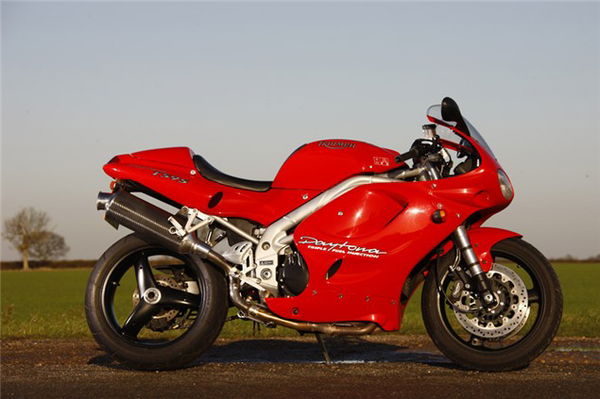
1997 Suzuki TL1000S
Suzuki’s mental V-twin quickly gained a reputation as a fearsome, tank-slapping, beast, instantly gifting it cult status. Is it a well-founded reputation?
Click to read: 1997 Suzuki TL1000S
Reputations. Once you get one it sticks firmer than chain lube to a rear wheel. Launched in 1997 the TL1000S quickly gained a reputation as a tank-slapper and after a few rider fatalities Suzuki were forced to recall the bike and retro-fit a rather ugly steering damper. Bad news? Not really, this reputation as an animal cemented the TL’s place in history and it became the bike to be seen on, a man’s bike and one that only a proper rider could tame.
Oddly enough, despite a limited four year production run, secondhand TLs are plentiful but getting a good one is tricky. In the 1990s Suzuki’s build quality was comparatively poor and exposing the TL’s engine to salt and road crud did it no favours. Secondhand ads are full of tatty TLs or ones that have been modified and abused, so it’s worth hanging out and getting a good one, like we found here.
With over 24,000 miles on the clock, a quick glance says although it’s not factory fresh, a good clean and a bit of polish would work wonders. But do you really buy a TL to keep it mint? A TL is a workhorse of a classic, rather than a sunny day treat. But can this so-called evil bike even be ridden?
Yes. In the late 1990s riders simply weren’t used to the explosive power of the TL’s engine, which goes a long way to explaining how it gained its reputation. Open the throttle and the 996cc twin kicks like a mule and gallops forward with real ferocity and a very abrupt and direct feel. A claimed power of 125bhp (realistically 110bhp at the rear) was a lot of grunt for a twin in 1999 and the TL delivers its power in a no-compromise fashion. But ten years ago it was something new. This is all part of the TL’s charm. Even compared to modern tackle the motor feels fast, exciting and gutsy. Yes it is a bit too direct at initial throttle openings, but that just makes it more thrilling and enhances the ride. You don’t have to change up and down the gearbox (which is beautifully slick, unlike the Triumph’s). The engine has stacks of V-twin midrange. It vibrates and pulsates, the bars tingle from two huge pistons slapping up and down in the cylinders below. And speaking of slapping…
Our TL has a replacement Öhlins rear damper, not the rotary unit. I’ve ridden my fair share of TLs and although they do wallow and wobble a bit in corners they’re a far cry from the sinister death-bike of repute. You can really hustle a TL down a twisty road and they don’t get THAT out of shape as long as you aren’t THAT aggressive with the throttle. Treat the twist grip as a switch and things can get a bit ‘interesting’. Keep it smooth and the TL will deliver a fun, fast and thrilling ride. Also, oddly enough, a relaxed one.
Many TL owners use their bikes as commuters or daily hacks. Engine layout makes the TL remarkably narrow, the seat’s very comfortable and bars reasonably relaxed. Throw a set of soft luggage over the pillion seat and away you go. Now, does this sound like some sort of widowmaker to you?
Suzuki TL1000S Essential Info
Prices
From £1,500 (1997, 34,000 miles) to £2,595 (2001, 15,000 miles)
Similar to the Daytona in that there are few used bikes around. Again owners seem to get attached to their machines and keep them for a number of years. The fully faired ‘R’ model is considered the saner of the pair, and there are far more of these around than ‘S’ variants, while any unfaired bikes up for sale more than likely won’t have seen 30,000 miles on the odometer. Aftermarket rear shocks are common, as the original had a hard time keeping the back-end under control.
Instant upgrades
- Steering damper: the TL1000S has always had a reputation as a difficult bike to keep under control, so much so that in some countries importers added a steering damper before they sold the bikes. This seems to be a wise move, as a damper can help keep the flighty front-end in check on less than smooth roads. Hyperpro are well established in this area and offer a kit for around £330 (www.hyperpro.com)
- Rear shock: the well-documented problems with the standard rear suspension damper mean many aftermarket suspension manufacturers offer a replacement that should be a huge improvement over the original. Nitron have a range available for the TL, from sports to race use. From £295 (www.nitron.co.uk).
- Belly pan: with the ‘S’ model TL only having a top fairing, all kinds of road grime collects on the engine’s front cylinder. Powerbronze make a belly pan that will cover the exposed lower area of the bike, tidy up the looks and keep the engine clean. £60 (www.powerbronze.co.uk).
Parts costs
Headlight: £249.49
Clutch lever: £19.50
Mirror: £59.25
Servicing
Minor: £128.50
Major: £190
Common faults
Early model TL’s suffered myriad problems; poor throttle response, slipping clutches, oil spat out of the engine clogging the air filter. Obviously, Suzuki weren’t too happy about this and quickly fixed these issues for the ’98 bike. A problem they struggled to sort was the handling however, with numerous reports of accidents occurring due to the hyperactive nature of the machine. The rear shock’s rotary damper was blamed.
The rotary damper allowed the bike a short wheelbase, even with a V-twin engine, but struggled to flow enough oil for adequate suspension damping. It was also close to the engine and exhaust pipe, causing the oil to overheat, lose its viscosity and thus its damping ability.
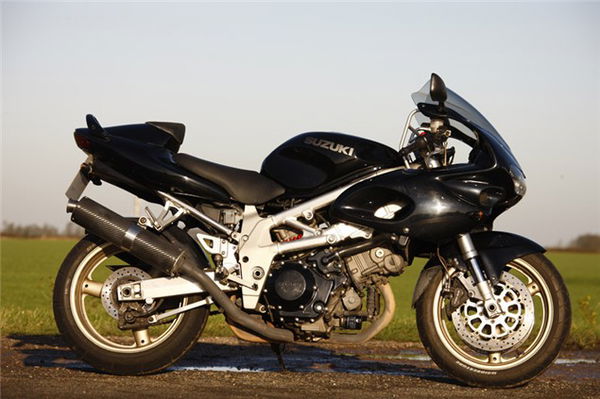
1994 Honda CBR900RR FireBlade
Supposedly one of the best paint schemes ever seen on a motorcycle on a bike that fathered the sportsbike revolution. Well, almost, there was a generation before…
Click to read: 1994 Honda CBR900RR Fireblade owners reviews
You’ve gotta love the 1994/5 FireBlade’s Urban Tiger paint scheme. Brave colours that sum up a period when bike sales were on the up and there was a genuine buzz about the industry. This is the second generation FireBlade and therefore purists will always turn their noses up at it. But because it isn’t the original it’s less sought after, has yet to reach ‘classic’ status and consequently the price is lower.
Sniff out a mint 1992 bike and you are looking at forking out more than £4,000 and even a tatty one will cost you £2,000 minimum. This bike, which is very tidy, has a price tag of just £2,500. So you get a bike that’s better than the original and nearly half the price. How can you lose?
Push the starter and the bike fires into life with no hesitation. This was the period when Honda made its reputation for build quality and despite this bike’s 32,150 miles on the clock it feels and sounds fresh as I blip the throttle to get heat into the motor. Blade engines are as solid as they come so hold no gremlins for the secondhand buyer, despite feeling a little rough.
The 893cc engine vibrates and rattles and feels a touch worn around the edges but I like this. It isn’t super-smooth and soul-less and like the TL it’s brimming with character. Hold the throttle open in first and the revs pick up quickly. As the mid-range nears its peak the front wheel gently lifts up in the air. This is a sixteen-year-old bike and it will happily wheelie off the throttle. With a claimed 124bhp the Blade may only be making modern 600 supersport power, but it has a stack of torque that 600 riders can only dream of. Despite its reduced weight, minimalist design philosophy the Blade has a huge tail-end with a comfortable riding position. I love the spartan nature of the cockpit, the huge gaps between the fairing and the clocks where a modern bike would have pointless plastic inserts to neaten it up. It’s all very retro yet also raw and purposeful.
Accelerate hard on the Blade on a bumpy road and things can get a bit lively. Very lively actually. This bike may have been in need of a bit of a suspension overhaul but the 16-inch front wheel and light weight combined to make it more than a bit of a handful on occasions. This, added to the fact the brakes were utterly horrid and devoid of any braking power, meant that I was reluctant to go ballistic on the Blade and didn’t enjoy it much in the corners either. Despite handling remarkably well considering its age, there was still a slightly odd feeling from the Honda’s front and a reluctance to turn. But we’re talking about a bike that’s pushing sixteen years old so I’m prepared to cut it some slack. Or should I?
The problem with this bike is it’s crossed a line. Where the TL and T595 are modern bikes, the Blade is a proper classic, with slight handling issues. If you know it won’t handle like modern tackle but it makes you feel good it really isn’t an issue. And riding the Urban Tiger certainly made me feel good.
Honda CBR900RR Fireblade Essential Info
Prices
From £1,600 (1994, 30,000 miles) to £2,700 (1995, 22,000 miles)
FireBlades were the bikes to be on in the mid 1990s – light, sharp and potent – outclassing every other sportsbike of the day. Their popularity 15 years ago means there are plenty of secondhand Blades around. Spend some time scouring the ads and a well looked after example can be had for around £2000. This may seem pricey for such an old machine but they’re becoming more popular as future classics and with no reliability issues, interest is high. Urban Tiger models are the most sought after.
Instant upgrades
- Brake pads: when new the FireBlade had class leading braking performance but as with many parts of the bike, they can deteriorate with age and become less than impressive. The original braking system still works well now if regularly serviced, but brake pad technology has moved on. Treat the bike to some EBC HH sintered pads along with a service to get the stopping power bang up to date for £23.50 (www.ebcbrakes.com).
- Exhaust: to enjoy the full aural experience of an early Blade, stick an end-can on. There’s a wide range to choose from, Remus popular with some owners for a pleasing but not deafening sound. From around £240 (www.remus.at).
- Rear shock: older bikes can really benefit from replaced suspension parts, with too many miles on the clock the shock loses its damping qualities. Maxton can tailor a shock to any rider, taking into account their weight, riding style and the kind of roads being ridden on. From £475 (www.maxtonsuspension.co.uk).
Parts costs
Headlight: £326.38
Clutch lever: £12.69
Mirror: £66.65
Servicing
Minor: £130
Major: £350
Common faults
Honda built up a reputation for excellent build quality during the nineties and with the FireBlade a flagship model, quality wasn’t sacrificed in many areas. 90’s Blades should run like clockwork if properly looked after and are quite able to rack up huge mileages with minimum fuss.
The one area where Honda weren’t quite so hot back then was the regulator/rectifier unit, which can cause starting grief due to the battery not being charged correctly. Any electrical issues with these bikes can usually be traced back to that. The only other things to look for would be general age related wear and tear, such as corrosion from many winters or poor fuelling from badly set up aftermarket pipes or race systems.

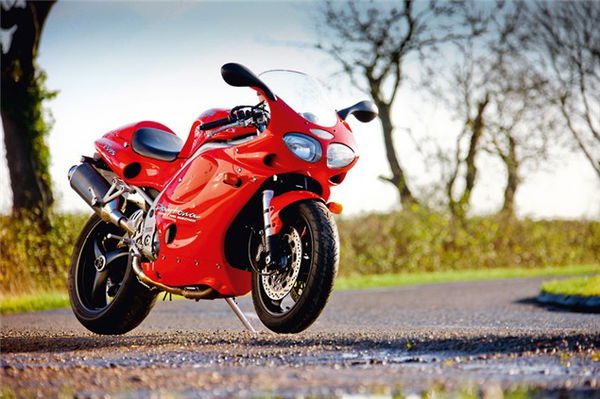
Verdict
This test threw up one real surprise, the Triumph T595 Daytona. Having dipped under the radar for so many years it was pleasantly surprising to find out what a wonderful bike it is. There were some reliability issues on the early models and the gearbox makes itself felt but the engine is a joy, the handling reassuring and the swoopy bodywork and flowing lines lovely. Having spoken to various dealers it would seem the T595 is a bit of a hidden gem. They seldom spend many days in showrooms as there’s an underbelly of Triumph owners who know all too well about their charms and little idiosyncracies too. I’m sorry for exposing a secret to the world but the T595 should be sampled by many more riders. It’s a great bike that will hit classic status very soon (if it hasn’t already). Just keep an eye on costs, though!
The TL provided exactly what I expected: big, gutsy V-twin performance in a chassis that handled passably, if not spectacularly. But what I wasn’t expecting was its potential as a great day-to-day bike. You aren’t going to buy a TL as an investment to ride only on sunny days. But an original could be a great workhorse to see you through the daily grind, win a special place in your heart and eventually be rewarded for its service with a full restoration job in a decade or two. Do this and it’s unlikely to be money wasted. The TL is certainly a classic.
Which leaves the Honda. I have a problem with this particular model. It’s not with the bike, which delivered exactly what it promised, a great engine, seriously cool retro look and slightly suspect handling. It’s with me. I am that anally retentive person and even though I love the Urban Tiger look, it’s just not a 1992 model. The Blade is compromised because it’s already a classic. If I’m buying a bike as a classic I’m prepared to put up with compromises, but only if it’s because it’s a real classic. I don’t care about iffy handling if I’m riding a bike that’s a slice of history. On a sunny day, I’m living the moment. Unfortunately for me the 1994/95 bike just isn’t special enough, so I’d rather buy a TL or T595 and enjoy riding them for their modern handling. If the Urban Tiger ticks your boxes then get one and enjoy. It’s better than an original. But it isn’t the original. Sorry, I’ll get my anorak…
��
